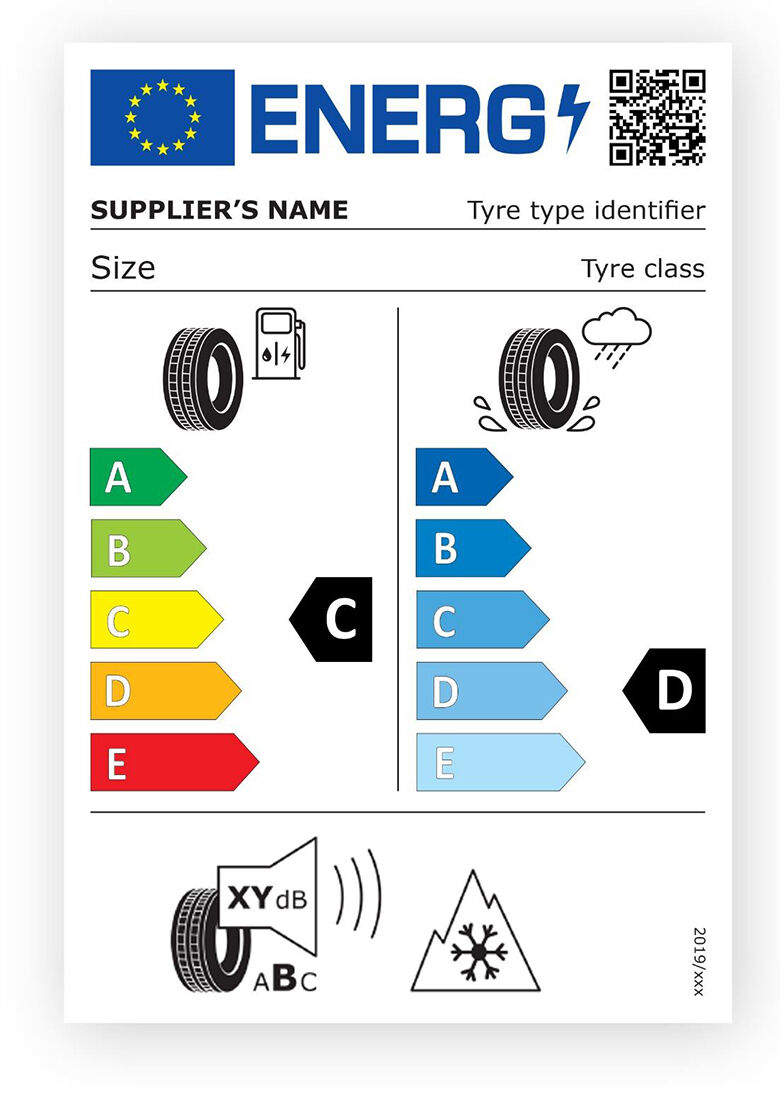All you have to know about EU Tire Label
EU Tire label explained
The EU tyre label provides important safety and environmental information about each tyre. It helps you compare tyres for wet grip, fuel efficiency and noise.
Where can I find the tyre labelling?
It should be on the tyre itself – it’s the law to provide an EU tyre label. But if you can’t find it on the tyre, ask your dealer or look on our website.
Fuel efficiency
Did you know that tyres account for up to 20% of your vehicle’s fuel consumption? Choosing tyres with a high fuel efficiency rating will give you more miles from your tank and lower your CO2 emissions.
What makes a tyre fuel-efficient?
Simply put, fuel-efficient tyres require less energy to roll. This ultimately translates into less fuel used.

How is fuel efficiency rated?
Fuel efficiency is rated from A to G on a colour-coded scale.
- A (green) = highest fuel efficiency rating
- G (red) = lowest fuel efficiency rating
- Rating D is not used for passenger cars

What the tyre fuel ratings mean
The difference between an A rating and a G rating could mean a reduction in fuel consumption of up to 7.5%. To put this in real terms, choosing A-rated tyres instead of G-rated tyres could save you more than 6 litres of fuel every 1,000 kilometres.*
At an average petrol price of 1.50€ per litre, that adds up to cost savings of more than 300€ over the life of the tyres.*
Don’t forget, you’ll also be reducing your environmental impact!
What else affects fuel efficiency?
- Low tyre pressure.
Not inflating your tyres properly increases rolling resistance and affects grip in wet conditions.
- The weight of your vehicle.
How much your car weighs and how you drive it can also make a big difference. You can reduce your fuel consumption by driving in a more energy-efficient way (also known as ‘eco-driving’)
Label values shown are for illustrative purposes only. Values for a certain tyre line/size may vary.
*Based on an average consumption of 8 litres/100km, a fuel price of 1.50€/litre, and an average tyre mileage of 35,000 km. Actual fuel and cost savings may vary depending, among other things, on tyre pressure, vehicle weight and driving style.
Wet Grip
Tyres with a high wet grip rating will stop more quickly on wet roads when full brakes are applied.
What is wet grip?
‘Wet grip’ is the tyre’s ability to stick to the road in wet conditions. The EU rating focuses only on one aspect of wet grip – the wet braking performance of the tyre.
How is wet grip rated?

Wet grip is rated from A to F:
A = highest rating
F = lowest rating Ratings D and G are not used for passenger cars.
What the wet grip ratings mean

In an emergency situation, a few metres can make all the difference. For a passenger car applying full brakes from 50mph, a set of A-rated tyres will brake up to 18 metres shorter than a set of F-rated tyres. *
Note: You should always respect the recommended stopping distances when driving.
*When measured according to the test methods set out in Regulation EC 1222/2009. Braking distances may vary according to driving conditions and other influencing factors.
Label values shown are for illustrative purposes only. Values for a certain tyre line/size may vary.
Noise rating
Some of the pass-by noise a car makes comes from the tyres. By choosing a tyre with a good noise rating you can lower the impact of your driving on the surrounding environment.
What does the EU noise rating measure?
The EU rating measures the external noise emissions of the tyre in decibels.
Since many people are unfamiliar with decibel values, a loudspeaker image with black waves is shown to signify how noisy the tyre is. The more waves there are, the louder the tyre.
- 1 black wave: Quiet (3dB or more below the European limit)
- 2 black waves: Moderate (between the European limit and 3dB below)
- 3 black waves: Noisy (above the European limit)

Αυξανόμενος Θόρυβος
What the noise ratings mean
Decibel levels are measured on a logarithmic scale. This means that an increase of just a few decibels represents a big difference in noise levels. In fact, a difference of 3dB doubles the amount of external noise the tyre produces. Think about the many thousands of cars on our roads each day. If we all chose tyres with lower noise ratings, imagine how much quieter our towns and cities would be.















